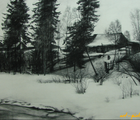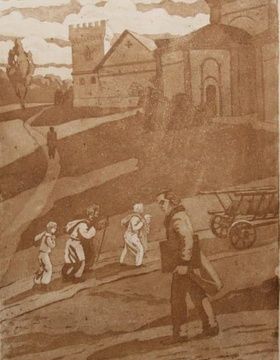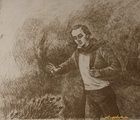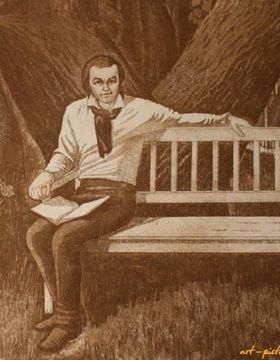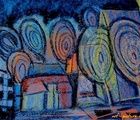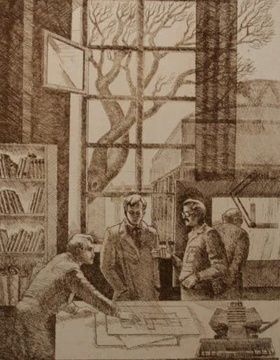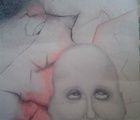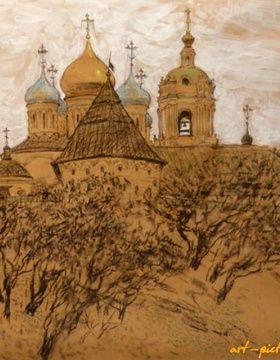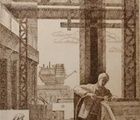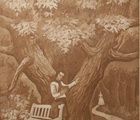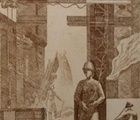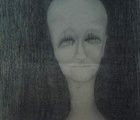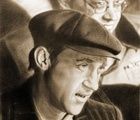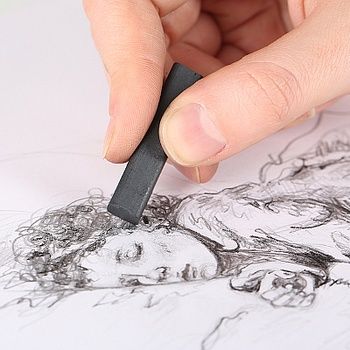
Мягкость угля и спрессованных мелков облегчает работу с тонами в графике, а заточенные угольные карандаши позволяют добиваться максимальной детализации даже на небольшом холсте.
Уголь
Хотя уголь преимущественно используют для набросков и подмалевков, мастера графики выбирают его как основной материал для работ. Альбрехт Дюрер (художник эпохи Возрождения, известный реалистичными портретами и обилием деталей) добивался поразительной реалистичности изображения кожи и волос, возрастной пигментации, фактуры материи и т.д. с помощью совмещения нескольких техник работы с углем.
Сангина и сепия
Красно-коричневые оттенки сепии, сангины и других мелков с натуральными пигментами идеально подходят для передачи естественных тонов кожи человека. Этим свойством пользовался Леонардо да Винчи в своих легендарных анатомических рисунках, портретах и автопортретах. Мелки легко заполняют пространство: попробуйте широкоформатные наброски природы и сельской местности и почувствуйте, насколько проще в сравнении с карандашом ложится материал.
В зависимости от плотности концентрации пигмента и процента воска в составе, мелки и карандаши могут быть темнее или светлее. Эти материалы хорошо смешиваются и переходят друг в друга, их легко растушевывать, а карандаши подходят для детальной проработки рисунка.
Соуc
Один из самых мягких материалов в графическом рисунке. Зарубежные художники про него почти не знают, зато он был популярен среди лучших русских живописцев – Репина, Саврасова, Крамского и т.д. Соус практически не поддается сухой растушевке, поэтому проработка деталей через штрихование невозможна.
Выразительность графики, написанной соусом, достигается за счет сочетания «акварельного» и традиционного способа нанесения пигмента. Поверхность рисунка покрывается общим тоном, затем наиболее светлые места высветляются с помощью ластика или клячки. Тёмные участки закрашиваются сухим слоем соуса или углем после полного высыхания подложки. Из-за вязкости материала и невозвожности детальной штриховки соус не выпускают в карандашной оболочке. Хотите попробовать проработку крупных деталей соусом? Заточите мелок до точки перочинным ножом. Сохраните ссыпавшийся пигмент, чтобы использовать для влажного рисования. Существует 10 основных оттенков соуса. В них входит черно-серая палитра, естественные оттенки желтого и зеленого, коричневые тона, сизый и т.д. Начинающим рекомендуется ограничиться 2-3 темными оттенками: даже небольшого бруска соуса хватит на 1-3 года плодотворной работы, если пользоваться преимущественно жидким способом нанесения пигмента.
Современные живописцы приобретают уже готовый уголь. Чтобы научиться его умело выбирать, необходимо постоянно практиковаться и пробовать продукцию разных фирм, ведь очень часто при выборе материала художники ориентируются в основном на личные предпочтения. Однако, некоторых самых известных производителей угля для живописи все-таки можно выделить.
Виды углей для рисования
Рисовальный уголь бывает двух видов: обычный древесный уголь и прессованный. Прессованный чернее и жирнее, чем древесный. Изготавливают его из угольного порошка (при этом используя наиболее черные сорта), с применением растительного клея в качестве связующего вещества. Прессованный уголь продают в виде палочек, они бывают трех номеров твердости.
Прессованный уголь, как и древесный, требует закрепления. Хотя держится на бумаге немного лучше. Бумага для рисования углём
При работе с углем нужно использовать шероховатую бумагу, с идеально гладкой поверхности он осыпается. Можно использовать бумагу для пастели или специальную для угля. Интересный живописный эффект можно получить, используя бумагу для акварели – яичную скорлупу, холст, лен. Можно использовать и плотную чертежную, предварительно потерев ее мелким наждаком или жесткой резинкой. Интересные работы также можно сделать используя тонированную бумагу, для создания бликов на ней можно использовать белый мел или пастель.
Для работы бумагу закрепляют на планшете, предварительно смочив ее водой. После высыхания бумага равномерно натянется, и на ней удобно будет работать.

